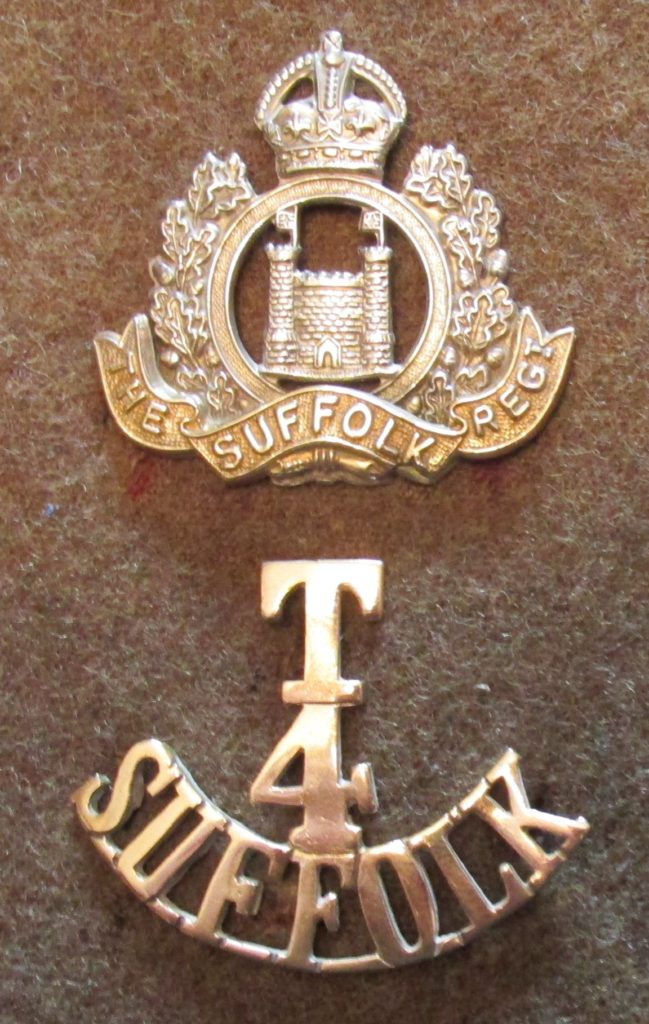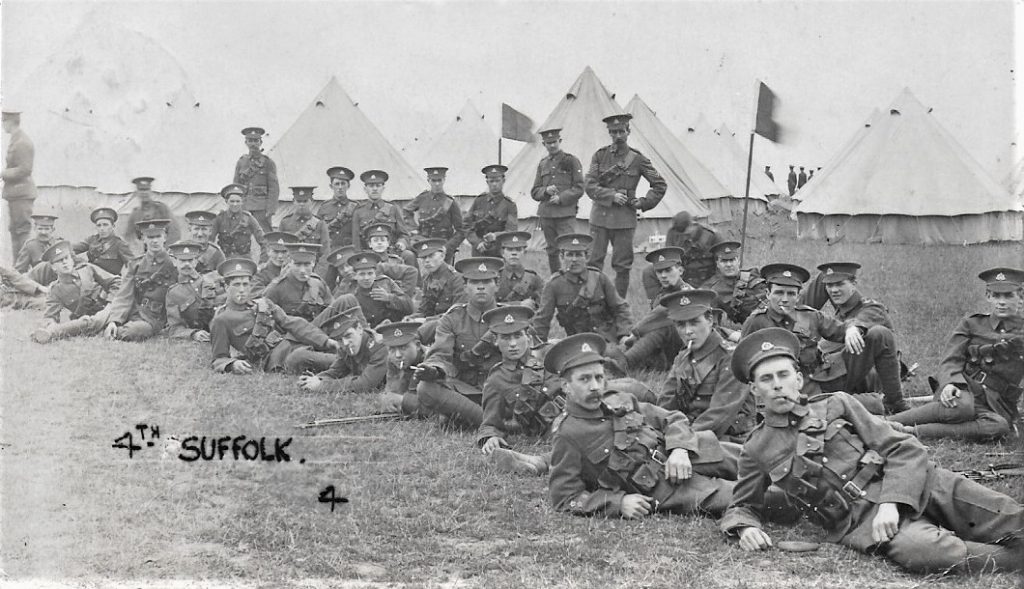1214 PRIVATE EDWARD MORGAN THOMAS
1ST/4TH BATTALION SUFFOLK REGIMENT
KILLED IN ACTION
12TH MARCH 1915
AGE 21 YEARS
Edward was born at Smallburgh in the County of Norfolk on 24th May 1893 and later baptised Edward Morgan Mathias Thomas on 6th March 1895 in the nearby town of North Walsham. He was the fourth of eight children of Thomas Morgan Thomas at that time the bank manager of the local branch of the London and Provincial Bank. His mother, Mary (née Shibley), had run the family home with the aid of two domestic servants. For an unknown reason, at the time of the 1901 census, Edward with his younger sister Frances was found living with their maternal grandfather, Walter Shibley, the owner of the Magpie Hotel near Harleston in Norfolk, while their parents remained living in North Walsham. Very little can be found of Edward’s early life and education but by the time of the 1911 census, aged seventeen years, he was boarding with the Walton family in the east Suffolk town of Leiston, while working as an engine fitter for the well known local company of Richard Garrett and Sons, manufacturers of steam traction engines and farm machinery. While employed there he would have been encouraged to join the ‘H’ Leiston Company, Territorials of the 4th Battalion Suffolk Regiment T.F. Why the Garretts were so keen on the younger members of their workforce enlisting in the Territorials can be explained by the fact that their pre-war battalion Commanding Officer was Lieutenant Colonel Frank Garrett T.D. who also had his son, Captain Stephen Garrett, serving in ‘H’ Company. Edward’s regimental number of 1214 shows that he enlisted in early 1911 to serve as a Private Soldier. This raises the question why, he was the son of a fairly well-to-do family with a father who had been able to send his older brother Arthur to a fee paying school, which then enabled him to secure employment in a more middle-class career in the insurance market. Edward on the other hand, had begun his working life learning a manual trade? It also seems strange that he and his sister were not living with the rest of their family when they had room for two servants to live in their home.
On 4th August 1914 Great Britain declared war against the Kaiser’s Germany as has been reported in some of our other stories of the men remembered on the Halesworth war memorial, Edward, during the previous days, had been attending with his comrades of the 4th Suffolks, their annual two-week training camp, being held at Great Yarmouth. Within a short time of their arrival they had been returned to their home towns to await further developments. This came at midnight on 4th August when the whole of the Territorial Force were mobilised for war. Within three months, having received further training, they were declared fit to fight. On 8th November 1914 the 1st/4th Suffolks, now consisting of four combined companies as opposed to the pre-war eight based on their local drill halls, crossed to France. They thus became one of those first Territorial Force battalions rushed to the Continent to reinforce the men of the Regular Army who with their Belgium and French allies, had suffered several costly defeats and losses in manpower. One example was that of the 2nd Battalion Suffolk Regiment which had, between 21st and 26th August 1914, lost, from a strength of almost one thousand officers and men, over seven hundred and twenty all ranks, killed, wounded or made prisoners of war. On landing at Le Havre and having originally served in the Norfolk and Suffolk Brigade, Lt Col Garrett was instructed to join the recently arrived Jullundur Brigade of the Indian Lahore Division. These men had been some of the first Empire troops to join Britain in the fight against Germany, having landed in the French port of Marseilles on 26th September 1914. At that time, in each of the Division’s three Brigades there had been one British Battalion serving. In the Jullundur Brigade, it was the men of the 1st Battalion Manchester Regiment, who then went on to mentor the soldiers of the 1st/4th Suffolks in the tactics of static trench warfare and of attack. On 14th December 1914 the Leiston men, now serving in the new ‘D’ Company which had been combined with the old ‘E’ Lowestoft Company, entered a section of the front line with their comrades from the 1st Manchesters in the area of Annequin, a village in the Pas-de-Calais region of Northern France. It was while they were there that the 1st/4th Suffolks suffered their first fatal casualty to be killed in action. Private Robert Larter who had been born and raised in Holton, the village close to Halesworth , but by the early 1900s he was a resident of Leiston, employed at the Garrett Works. Sadly Robert’s death would be the first of many hundreds that the 4th Suffolks would suffer during the next four years of warfare. At the start of the new year of 1915 the battalion settled down to the routine of spending time both in and out of the firing line, with the Suffolk soldiers continuing to be fascinated by the food and customs of their Indian comrades. On 23rd February they lost the service of their much respected Commanding Officer Lt Col Garrett, who had been ordered into hospital. Shortly after, on 10th March, now under the command of Lt Col Cruddas, they marched to Vielle Chapelle where they then prepared to take part in their first full-scale attack on the German line, in the area of Neuve Chapelle. The Suffolk Regimental History, published in 1928, reported that the assault of 11th March 1915 had begun at twelve noon but, due to stubborn resistance by the enemy, little in the way of an advance could be made, with the men of the 4th Suffolks eventually being pulled back later in the evening. Shortly after first light the following day, they had received orders to resume the attack after the British artillery had laid waste to the German barbed-wire defences and a number of their strong points. As their Brigade advanced over a broad front the German artillery retaliated, causing a large number of casualties among the advancing Indian and British troops. However, eventually, sections of the enemy’s trench system had been captured with the German troops being driven out of their well-entrenched positions. It was later claimed that the battle of Neuve Chapelle had been the first occasion in which British and Empire troops had driven the enemy out of their front line. As might be expected, this victory came at a cost, with the Suffolk Territorials having reportedly suffering two hundred and seventeen of their soldiers lost, including poor Edward, while amongst the Officers fatal casualties one had been Captain Stephen Garrett. Also killed on that day was the Halesworth lad, Robert Bird (see his story), while his original Company Commander from the town, Captain F J Rodwell, one of Halesworth’s Solicitors, received wounds. There seems to have been some confusion as to Edward’s fate, as the Halesworth Times newspaper, in both the editions of 27th April 1915 and 29th June 1915, reported that he had been wounded on 12th March, while the second edition also stated that he had been reported as missing. Sadly there were no other reports by the family regarding his loss, although they presumably put his details forward for his name to be included on the Halesworth war memorial. As to Edward’s remains, either he had not been identified or found on the battlefield, as he is remembered today on the Le Touret Memorial to the missing.
After his death his father Thomas who had been listed as his next of kin received a gratuity payment totalling £10.0s.7d (£10.02p) in August 1919.
His parents would also have been entitled to claim his medal awards of the 1914 Star medal trio, with his named memorial plaque and scroll.
The location of these is unknown.
The above postcard shows soldiers of the 4th Suffolk Territorials
who were attending their annual training camp held at
Dibgate Camp, Shorncliffe, Kent in July 1913.
Could Edward be among them?


